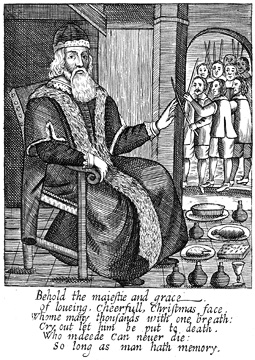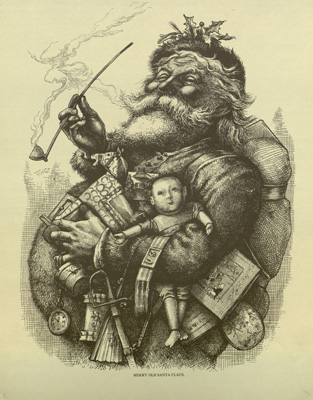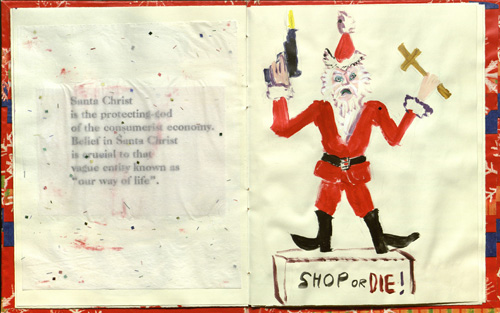The legend of St. Nicholas of Myra has taken so many twists and turns over the centuries that he is barely recognizable to us anymore. Instead, he has been replaced by a jolly, bearded, portly man in a red suit and cap and coal black boots. For this installation of Scripta Manent, we will trace the history of St. Nicholas/Santa Claus/Father Christmas/Kris Kingle, just in time for Christmas. The real St. Nicholas was born in Asia Minor during the third century in the city of Myra (in present-day Turkey). He was the only son of wealthy Christian parents named Epiphanius and Johanna according to some accounts and Theophanes and Nonna according to others. His wealthy parents died while Nicholas was still young and he was raised by his uncle—also named Nicholas—who was the bishop of Patara.
In 325, Nicholas attended the Council of Nicaea. There, Nicholas was a staunch anti-Arian and defender of the Orthodox Christian position that Jesus was fully divine and fully human, and one of the bishops who signed the Nicene Creed. Legend holds that he was so angry with Arius (who taught that Jesus was only a man) that Nicholas punched him in the face. However, the most famous legend associated with St. Nicholas is that of the poor man with three daughters. In the tale, the man could not afford a proper dowry for his daughters. Hearing of the poor man's plight, Nicholas decided to help him, but being too modest to help the man in public, or to save the man the humiliation of accepting charity, he went to his house under the cover of night and threw three purses (one for each daughter) filled with gold coins through the window opening into the man's house. There are different variations of the story. One has Nicholas throwing the bags down a chimney. Another embellishes the story and has a daughter’s stocking hanging over the embers of the fireplace to dry, where the bag of gold dropped straight in.

In the ensuing centuries, the story of St. Nicholas has evolved. Beloved by children all over the world, St. Nicholas/Santa Claus/Father Christmas/Kris Kringle brings gifts to good boys and girls on Christmas (and sometimes coal to bad children). However, he has not always been the most beloved of figures. In 1686, Josiah King published a pamphlet called The Examination and Tryal of Old Father Christmas. In the pamphlet, Father Christmas is put on trial by those who worry that Christmas is becoming too materialistic and too much of an excuse to party and commit debauchery. In the end, Father Christmas is acquitted of his charges, and yet he is admonished by the judge to remember that Christmas is about Jesus.
Although Father Christmas was usually thinner and wore a green coat, the modern idea of a rotund jolly man in a suit came about with the publication of A Visit from St. Nicholas by Clement Clark Moore in 1823. However, Moore’s Santa was an elf with a miniature sleigh and eight tiny reindeer. It was Thomas Nast’s subsequent illustrations that helped cement the image of the modern Santa Claus in the minds of most Americans. The idea that Santa Claus resides at the North Pole may also be attributed to Nast. One of his illustrations is entitled “St. Claussville, N.P.” Another depicts two children drawing Santa’s route to their house from the North Pole.

One of the most famous writings involving Santa Claus came from a newspaper column in the New York Sun. Little 8-year old Virginia O’Hanlon wrote a letter to the editor asking if there really was a Santa Claus. As her letter says, her father told her that “if [it is] in the Sun, it’s so.” Her letter was answered eloquently and reassuringly by Francis Pharcellus Church, whose line “Yes, Virginia, there is a Santa Claus” is often quoted more than a century later. It remains the most reprinted editorial ever to run in any newspaper in the English language.

In the 20th and 21st centuries, the image of Santa Claus has been used for all sorts of advertisements. The most famous may be the Coca-Cola Santa Claus, which debuted in the 1920s. During World War II, Santa was depicted with a helmet to ask Americans at home to send Christmas gifts overseas to soldiers fight in Europe and the Pacific. However, not everyone is thrilled with the overexposure of Santa Claus. Fred Rinne’s hand drawn artist book, God Santa Christ depicts Santa Claus as a creation of a consumer culture. As he writes:
Santa Christ/is the protecting god/of the consumerist economy/Belief in Santa Christ/is crucial to that/vague entity known as/"our way of life".

However, it is the spirit of giving to those in need that the original St. Nicholas represents. It is our hope here at Special Collections that this spirit touches you, dear reader, and that you intently research local and national charities before giving to those in need this season. By doing so, you keep the spirit of St. Nicholas and Santa Claus alive. Merry Christmas and Happy Holidays to everyone. See you in 2013!